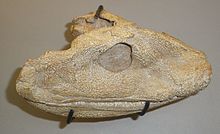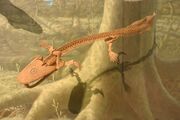
| Acanthostega | |
|---|---|

| |
| An artist's illustration of Ainiktozoon loganense | |
| Scientific classification | |
| Kingdom: | Animalia |
| Phylum: | Chordata |
| Family: | Acanthostegidae |
| Genus: | †Acanthostega Jarvik, 1952 |
| Species: | †A. gunnari |
| Binomial name | |
| †Acanthostega gunnari Jarvik, 1952 | |
Acanthostega gunnari (meaning "spiny roof") is an extinct genus of stem-tetrapod, among the first vertebrate animals to have recognizable limbs. It appeared in the late Devonian period (Famennianage) about 365 million years ago, and was anatomically intermediate betweenlobe-finned fishes and those that were fully capable of coming onto land.
Description[]
The 60 cm (24 in) Acanthostega had eight digits on each hand (the number of digits on the feet is unclear) linked by webbing, it lacked wrists, and was generally poorly adapted for walking on land. It also had a remarkably fish-like shoulder and forelimb.

Skull
The front foot of Acanthostega could not bend forward at the elbow, and thus could not be brought into a weight bearing position, appearing to be more suitable for paddling or for holding on to aquatic plants. Acanthostega is the earliest stem-tetrapod to show the shift in locomotory dominance from the pectoral girdle to the pelvic girdle.
There are many morphological changes that allowed the pelvic girdle of Acanthostega to become a weight-bearing structure. In more ancestral states the two sides of the girdle were not attached. In Acanthostega there is contact between the two sides and fusion of the girdle with the sacral rib of the vertebral column. These fusions would have made the pelvic region more powerful and equipped to counter the force of gravity when not supported by the buoyancy of an aquatic environment. It also had lungs, but its ribs were too short to support its chest cavity out of water, and it also had internal gills that were covered like those of fish, as opposed to some modern amphibians that are fully aquatic.

Reconstructed skeleton
It has been inferred that Acanthostega probably lived in shallow, weed-choked swamps, its legs being not an adaptation to walking on land. Jennifer A. Clack interprets this as showing that Acanthostega was primarily an aquatic animal descended from fish that never left the sea, and that the specializations in the tetrapod lineage developed features which would later be useful for terrestrial life.
At that period, deciduous plants were flourishing and annually shedding leaves into the water, attracting small prey into warm oxygen-poor shallows that were difficult for larger fish to swim in; Clack remarks on how the lower jaw of Acanthostega shows a change from those of fish that have two rows of teeth, with a large number of small teeth in the outer row, and two large fangs and some smaller teeth in the inner row. This difference likely corresponds to a shift in stem-tetrapods from feeding exclusively in the water to feeding with the head above water or on land.
While normally considered more basal than Ichthyostega, it is possible that Acanthostega was actually more derived. Since Acanthostega resembles juvenile Ichthyostega and shows a lot less differences from juveniles to adults than the latter, it has been suggested that Acanthostega might be descended from a neotenic lineage. Although it appears to have spent its whole life in water, its humerus also exhibits traits that resemble those of later, fully terrestrial stem-tetrapods (the humerus in Ichthyostega is more similar to earlier fishes). This could indicate that vertebrates evolved terrestrial traits earlier than previously assumed, and numerous times independently from another.
Research based on analysis of the suture morphology in the skull of Acanthostega indicates that the species was able to bite prey at or near the water's edge. Markey and Marshall compared the skull with the skulls of fish, which use suction feeding as the primary method of prey capture, and creatures known to have used the direct biting on prey typical of terrestrial animals. Their results indicate that Acanthostega was adapted for what they call terrestrial-style feeding, strongly supporting the hypothesis that the terrestrial mode of feeding first emerged in aquatic animals. If correct, this shows an animal specialized for hunting and living in shallow waters in the line between land and water. Newer research also indicates that it is possible Acanthostega evolved from an ancestor that had more terrestrial adaptations than itself.
Discovery[]
The fossilized remains are generally well preserved, with the famous fossil by which the significance of this species was discovered being found by Jennifer A. Clack in East Greenland in 1987, though fragments of the skull had been discovered in 1933 by Gunnar Säve-Söderbergh and Erik Jarvik.
In popular culture[]
- Acanthostega appears in Jurassic World: The Game as a legendary amphibian.
- It also appears in Animal Crossing: New Horizons as a one-part fossil.
References[]
- http://www.devoniantimes.org/Order/re-acanthostega.html
- https://www.thoughtco.com/overview-of-acanthostega-1093636
- https://www.nature.com/articles/nature19354
- https://royalsocietypublishing.org/doi/10.1098/rspb.2013.2689
- https://www.theclacks.org.uk/jac/Acanthostega.html
- https://journals.plos.org/plosone/article?id=10.1371/journal.pone.0118882
Gallery[]
Acanthostega/Gallery